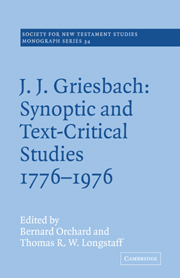Book contents
- Frontmatter
- Contents
- Portrait of J. J. Griesbach
- Copy of Colloquium announcement
- List of participants and selected observers
- Preface
- Abbreviations
- 1 The genesis of the Colloquium
- 2 Johann Jakob Griesbach: his life, work and times
- 3 The Gospel synopsis from 1776 to the present day
- 4 Griesbach's answer to the Synoptic Question
- 5 Commentatio qua Marci Evangelium totum e Matthaei et Lucae commentariis decerptum esse monstratur
- 6 A demonstration that Mark was written after Matthew and Luke
- 7 Griesbach and the development of text criticism
- 8 Modern text criticism and the Synoptic Problem
- 9 At the Colloquium's conclusion
- 10 The Griesbach Hypothesis: a bibliography
- Notes
- Appendix
- Index
4 - Griesbach's answer to the Synoptic Question
Published online by Cambridge University Press: 23 December 2009
- Frontmatter
- Contents
- Portrait of J. J. Griesbach
- Copy of Colloquium announcement
- List of participants and selected observers
- Preface
- Abbreviations
- 1 The genesis of the Colloquium
- 2 Johann Jakob Griesbach: his life, work and times
- 3 The Gospel synopsis from 1776 to the present day
- 4 Griesbach's answer to the Synoptic Question
- 5 Commentatio qua Marci Evangelium totum e Matthaei et Lucae commentariis decerptum esse monstratur
- 6 A demonstration that Mark was written after Matthew and Luke
- 7 Griesbach and the development of text criticism
- 8 Modern text criticism and the Synoptic Problem
- 9 At the Colloquium's conclusion
- 10 The Griesbach Hypothesis: a bibliography
- Notes
- Appendix
- Index
Summary
Johann Jakob Griesbach (1745–1812) was active in Halle when he published his epoch-making Synopsis of 1774 which appeared separately in 1776. This instrument enabled him to apply himself to an exhaustive study of the literary relationships among the Gospels of Matthew, Mark and Luke. He later moved to Jena, and in 1783 gave scholars of Germany a hint of his Synoptic Theory. In 1789–90 this was fully elaborated and published under the title of Commentatio; in 1794 the study was republished with supplements. Similar theories had been put forward in Great Britain by Henry Owen in 1764 and in Germany by Anton Friedrich Büsching in 1766; but Griesbach mentioned neither of these.
The background of Griesbach's Synoptic Theory
The Synoptic Hypothesis of Griesbach was a modification of a theory which had prevailed down to his time, viz., the hypothesis of Augustine according to whom Mark had to be seen as the epitomizer of Matthew, but not of Luke (Augustine, De consensu evangelistarum, i. 2.4: ‘Marcus eum, scil. Matth., subsecutus tamquam pedisequus et breviator ejus videtur’; i. 3.6: ‘non habuit tamquam breviatorem conjunctum Lucas sicut Marcum Matthaeus’). Griesbach contradicted the second, negative proposition of Augustine, and affirmed that Luke had also been used by Mark. It was his synopsis that led Griesbach to this conclusion.
- Type
- Chapter
- Information
- Publisher: Cambridge University PressPrint publication year: 1979

